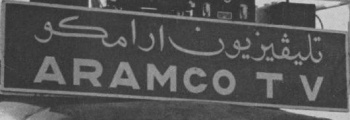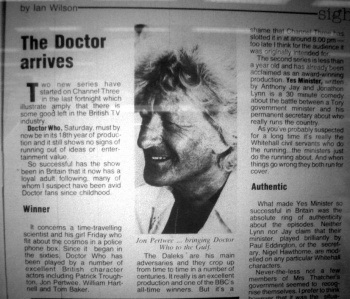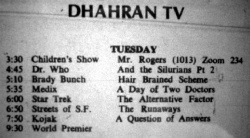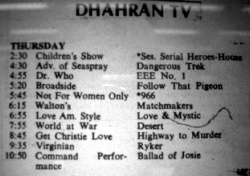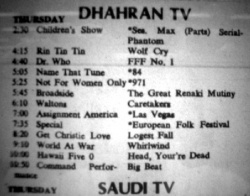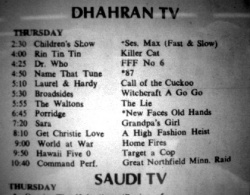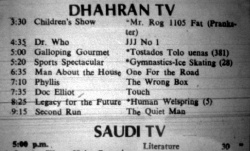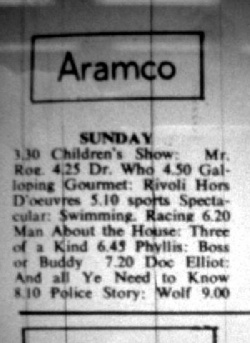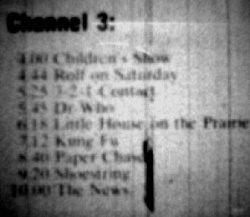Saudi Arabia
SAUDI ARABIA is a Middle Eastern country, between the Red Sea and the Persian / Arabian Gulf.
Profile
| Country Number (27) | 1968? | FIRST and SECOND WAVE |
| Region | Middle East | |
| Television commenced | 17 June 1955 | |
| Colour System 1 | 1973 | SECAM |
| Colour System 2 | 1976 | NTSC |
| Colour System 3 | 1979 | PAL |
| Population | 1969 | 7 million |
| TV Sets | 1969 | 29,000 |
| Population | 1977 | 8.1 million |
| TV Sets | 1977 | 130,000 |
| Language/s | Arabic | Dubbed or Subtitled |
Television Stations / Channels
Despite its vast size, television in Saudi Arabia is isolated to only two specific regions: Riyadh and Jidda in the west, and the south eastern provinces near Dhahran on the Persian Gulf. By 1970, it had six separate broadcasters serving the country.
AJL-TV
The second-ever television service to the Arab world was established in Saudi Arabia; commencing from 17 June 1955, station AJL-TV went on air in Dhahran on the Arabian / Persian Gulf. This NTSC service was operated by the United States Air Force, and was intended to provide entertainment to personnel at the Dhahran Air Force Base.
ARAMCO TV / HZ-22
On 16 September 1957, another NTSC broadcaster was established in the nearby compound of the Arabian American Oil Company (ARAMCO); Station HZ-22 (aka Dhahran TV) broadcast both Arabic and English programming. The English material was a mixture of dubbed, subtitled or narrated (in which the origin soundtrack played but with an Arabic voice-over providing narration). In the case of dubbed material, the original English soundtrack was broadcast by FM radio, allowing for simulcast in both languages.
When the new Damman station (see below) went on the air in 1970, ARAMCO ceased its Arabic service, and all subsequent broadcasts from HZ-22 were in English.
In November 1976, ARAMCO modified its monochrome 525-line transmitters to broadcast in NTSC colour. Three years later, in March 1979, it installed a PAL colour transmitter, which brought compatibility to the station and the neighbouring gulf nations (Bahrain, United Arab Emirates, Kuwait) that were already broadcasting in PAL.
The ARAMCO station eventually closed in 1998.
These sites contain further information about ARAMCO:
SAUDI TV
The Saudi government's Ministry of Information began its own television broadcasts from Riyadh and Jidda from 17 July 1965.
Colour transmissions on Saudi TV began in 1973 using the SECAM colour broadcast system.
OTHER STATIONS
Fourth, fifth and sixth separate broadcast services were established over the ensuing years, with the sixth of these launched in Damman in 1970.
Saudi viewers purchased dual-standard television sets to enable them to enjoy broadcasts coming from all the different stations, as all were broadcasting in different formats.
Broadcasts from Kuwait could also be received in eastern Saudi Arabia, and from 1973, colour transmissions from Bahrain could also be received.
Language/s
The principal language of Saudi Arabia is Arabic, although ARAMCO television broadcasts were also simulcast in English, for the benefit of the English-speaking workers at the oil-fields.
The dubbing and subtitling for programmes screened in Saudi Arabia was done in Lebanon.
DOCTOR WHO IN SAUDI ARABIA
الدكتور هو
Saudi Arabia was the 27th country to screen Doctor Who; it was the third to screen the series in Arabic (see Selling Doctor Who).
BBC Records
The Seventies records a sale of "(4)" stories by 28 February 1977. The Handbook identifies these as being: C, E, J and L.
The Eighties - THE LOST CHAPTERS records a sale of "(25)" stories (by 10 February 1987).
In DWM, Saudi Arabia is identified in 16 story Archives: the same four Hartnells as above, plus K, with year of sale given as 1967 or 1968; and for Pertwee, it is recorded under AAA, BBB, DDD, EEE, KKK, MMM, LLL, RRR, PPP, QQQ, UUU, with the year of sale being 1977.
Stories bought and broadcast
WILLIAM HARTNELL
Nine stories, 37 episodes:
| A | An Unearthly Child | 1 |
| B | The Daleks | 7 |
| C | Inside the Spaceship | 2 |
| E | The Keys of Marinus | 6 |
| F | The Aztecs | 4 |
| G | The Sensorites | 6 |
| J | Planet of Giants | 3 |
| K | The Dalek Invasion of Earth | 6 |
| L | The Rescue | 2 |
Saudi Arabia therefore bought the standard package of GROUP A, B and C of the William Hartnell stories dubbed into Arabic.
Origin of the Prints?
Tunisia and Morocco had screened the Hartnell stories by the time Saudi Arabia began so it's possible the prints sent to Saudi Arabia came from one of these two countries.
The programme was supplied as 16mm black and white film prints with Arabic soundtracks. It is possible that the broadcaster was also supplied with English prints, enabling a simulcast in both languages, with the English soundtrack available on radio.
JON PERTWEE
21 stories, 112 episodes (presumably):
| AAA | Spearhead from Space | 4 |
| BBB | Doctor Who and the Silurians | 7 |
| CCC | The Ambassadors of Death | 7 |
| DDD | Inferno | 7 |
| EEE | Terror of the Autons | 4 |
| FFF | The Mind of Evil | 6 |
| GGG | The Claws of Axos | 4 |
| HHH | Colony in Space | 6 |
| JJJ | The Daemons | 5 |
| KKK | Day of the Daleks | 4 |
| LLL | The Sea Devils | 6 |
| MMM | The Curse of Peladon | 4 |
| NNN | The Mutants | 6 |
| OOO | The Time Monster | 6 |
| PPP | Carnival of Monsters | 4 |
| QQQ | Frontier in Space | 6 |
| SSS | Planet of the Daleks | 6 |
| UUU | The Time Warrior | 4 |
| XXX | Death to the Daleks | 4 |
| YYY | The Monster of Peladon | 6 |
| ZZZ | Planet of the Spiders | 6 |
Saudi Arabia therefore bought all of GROUP A, B, C, and E, only some of D.
(Other BBC records indicate that the sale of The Three Doctors was "CANCELLED"; Strict Saudi censorship did not permit programmes that featured "god-like" beings, of which Omega may have been considered; The Green Death was never offered, possibly on account of its strong views against oil pollution...; and Invasion of the Dinosaurs was not available at all.)
ARAMCO was broadcasting in NTSC colour from 1976; since not all of the Pertwee stories were converted into NTSC by 1977, it is unclear in which format these episodes aired. U-Matic colour video tapes were in common usage by ARAMCO in the 1970s, so it is feasible that the BBC supplied ARAMCO with the first four Pertwee seasons in that format. However, the TV listings seem to denote colour programmes with an asterisk (*) and none of the Doctor Who listings are marked as such, which does suggest that, like much of the TV schedules at that time, these were in black and white.
ARAMCO was broadcasting in PAL colour after 1979. The four season 11 stories would have been supplied on PAL colour video tape in English.
TOM BAKER?
? stories, ? episodes
To account for the total of 25 stories as recorded by The Eighties, there may have also been a run of four Tom Baker serials (from season 12)?
Transmission
WILLIAM HARTNELL
We have not been able to access Saudi Arabian newspapers from the late 1960s, and therefore do not have any details on these transmissions.
The series would have screened on the Saudi TV or ARAMCO TV channel.
Fate of the Prints?
Jordan was the next Arabic country in the Middle East to air Doctor Who (from mid-1969). It is possible that Saudi Arabia sent its prints of the Hartnell stories to Jordan.
.
JON PERTWEE
Nine or so years after the William Hartnell Doctor featured on Saudi TV screens, the good Doctor returned in 1977.
The newspaper listings are a bit erratic from mid 1976 until the start of 1977, so we are uncertain as to the exact start date for the Jon Pertwee run, but the first clear listing is for part two of Doctor Who and the Silurians on Tuesday, 26 April 1977 on DHAHRAN TV (i.e. ARAMCO). (This start is only a few days after the brief run of Pertwee episodes commenced in Lebanon). The timeslots fluctuated, with the earliest at 4.45pm and the latest 5.55pm.
ARAMCO had dropped its Arabic programming in 1970, so these episodes were all broadcast in English. They were (most likely) also in black and white.
From 11 August 1977, the series shifted to Thursdays, usually at 4.55pm. From Sunday, 25 September, a second episode was added to the schedules (at 4.20pm), so the series played twice a week – Sundays and Thursdays. The timeslot for both weekly episodes fluctuated during the run.
There were two dates on which episodes did not air – 2 August 1977 and 22 September 1977; however the accuracy of the listings is under question for reasons outlined below.
The series did not screen in correct story order; in fact it looks very much as though the schedulers played the serials according to "theme" – after the serials from season 7 had aired, it seems ARAMCO may have run the first seven stories featuring Roger Delgado as the Master (from seasons 8 and 9) in a 'block' (there are certainly enough airdates for this to have been the case), followed by The Ambassadors of Death, then the first two Pertwee Daleks stories back to back, with a four-parter (Spearhead from Space, The Curse of Peladon, Carnival of Monsters?) to finish.
The only ten stories are identified by title or story code: Doctor Who and the Silurians, CCC, Inferno, EEE, FFF, GGG, HHH, JJJ, KKK, SSS, which accounts for 56 episodes.
According to the Gulf Mirror, the run lasted for at least 72 episodes, and concluded on Sunday, 19 March 1978. However, the Arab Times continued to list the series until 22 April 1978 – but for reasons outlined below, we have reason to doubt the accuracy of these Times listings.
A new run of only six episodes aired from Saturday, 8 July 1978, at 4.40pm. Again, no titles were given; presumably this 6-parter was either The Sea Devils, The Mutants, The Time Monster or Frontier in Space, as these are the only 6-parters not identified during the previous 1977-1978 run.
NOTE: There were no ARAMCO listings for Doctor Who in the Gulf Mirror between 20 April 1978 and 8 July 1978; however given that we are short several episodes, it is possible that these "missing" episodes have slipped under the radar. From 22 April, the usual Doctor Who slot was taken by the American comedy Dennis the Menace, but the accuracy of those listings is under question...
After a three year break, the series returned, now on the newly re-named Channel 3. The first episode was at 8.04pm on Saturday, 21 November 1981. This slot moved around a bit during the run, with 5.54 or 5.45pm being the two most common.
This 20-episode run was previewed by the article, "The Doctor arrives", in the Gulf Mirror which was illustrated with a photo of Jon Pertwee (See TV Listings below).
ARAMCO/Channel 3 had switched to PAL colour in 1979, so these 20 episodes would most likely have all been from season 11 (sans Invasion of the Dinosaurs).
The last episode was on 3 April 1982.
Assuming ARAMCO purchased all the available Pertwee stories, there are 10 to 14 episodes not accounted for. The first run was for (at least) 72 weeks/episodes; the second only six, and the third and last for 20. That is only 98 out of a potential 112. It is possible that Spearhead from Space didn't screen – there is no listing for it ahead of Doctor Who and the Silurians – which potentially leaves just one 4-parter and one 6-parter unaccounted for.
Fate of the Tapes?
Saudi Arabia appears to be the last ever country to screen a full run of season 7 to 10 Jon Pertwee stories from black and white film. With the exception of Bangladesh, who aired a handful in black and white in 1980, all other countries screened what was then left of the third Doctor stories in PAL colour.
.
TOM BAKER?
There is no clear record that Saudi Arabia screened Doctor Who after 1982. Gulf newspapers were checked up until 1984, but for most of that period there were no TV listings available for Channel 3.
The total of sales by 1987 recorded in The Eighties is 25, and there are only 21 Pertwee stories. Does this mean that there was also a short run of four Tom Baker stories in Saudi Arabia? If so, we have no further details.
TV listings
| ← AIRDATES ...... (CLICK ICON TO GO TO TABLE SHOWING EPISODE BREAKDOWN AND AIRDATES - N/S = story title is Not Stated) |
1960s
We have not been able to locate any newspapers with Saudi Arabian TV listings for this period.
1970s / 1980s
TV listings have been obtained from the Saudi newspaper Arab News (an English publication from Jeddah), and the Bahraini paper, the Gulf Mirror, which has full TV listings for most of the neighbouring Gulf countries (but no issues available prior to October 1977).
The Gulf Mirror printed the series title as "Dr Who". No story titles were given.
In the Arab Times, listings also gave the title as "Dr Who". Two of the serials were identified by name (with various different attempts at spelling "Silurians" and "Inverno" (sic)!)
Programmes marked with an asterisk (*) in the Times appear to denote that it is in colour. None of the 1970s listings for Doctor Who are marked that way, which suggests the episodes were all in black and white.
From the 11 August 1977 listing onwards, many episodes were identified only by the three-letter BBC production code and episode number, such as "EEE No 1", "CCC 1", "CCC EP 2", etc.
However it seems that the Times experienced a glitch in its printing process, as the TV listings started being duplicated over and over for several weeks, with as many as nine listings being given for "FFF No 4" over an eleven week period, from October to December 1977. Glitches of this nature continued to plague the listings, with one extreme example of the problem occurring when the very same programme details (which included "Dr Who: KKK No1") were repeated every day from 15 March 1978 through until 22 April! (from that date, Doctor Who was replaced by the American comedy series Dennis the Menace).
To add further frustration, the two papers do not always agree with the timeslots, particularly the Thursday episodes, which are timed around 4.00pm in Arab News, but as early as 2.45pm in the Gulf Mirror (it's possible this is due to the time difference between the two countries, but if so that should be only an hour, not two or more). Also making it hard to coincide the two sets of listings is that the Bahraini paper did not always date the days of the week of its pull-out TV guide, which sometimes started with Monday, sometimes Sunday, so it's possible we have "missed" some of the Sunday listings.
Given all these anomalies, we've done our best to combine the two sets of listings, but need to stress we do still have some uncertainty as to the accuracy of our valiant attempt!
In the Gulf Mirror issue dated 21-27 November 1981, the new run of episodes starting that week was previewed by Ian Wilson in his Sight and Sound column. The article, "The Doctor arrives", is illustrated with a captioned photo of the lead actor, and says: "Jon Pertwee … bringing Doctor Who to the Gulf". The article mentions that the series had been running for 18 years, and names the other three actors to have played the title character, although oddly, Wilson does not mention that the series had aired in Saudi Arabia in the sixties, or indeed only four years earlier!
Saudi Arabia in Doctor Who
- In his guise of Kalid, the Master said he learned his magic "in the deserts of Arabia", which in very broad terms could mean Saudi Arabia. (Time-Flight)
